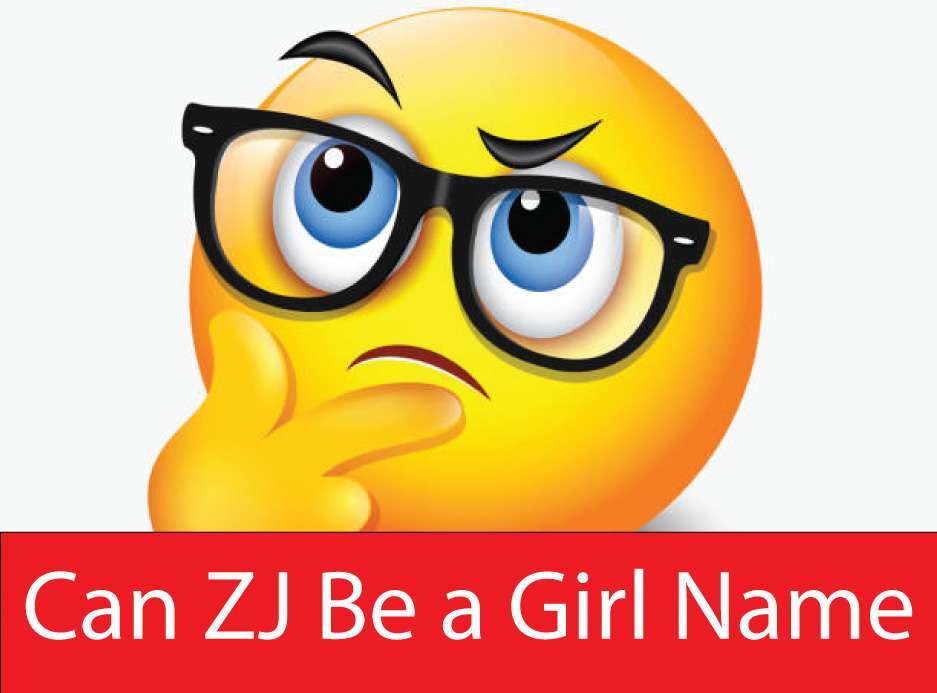When your baby turns one, the world becomes their playground—literally.
At this age, your little explorer is full of energy, curiosity, and a growing desire to move, touch, and discover everything around them.
That’s why choosing the right activities can help support their development while keeping them entertained (and giving you a tiny breather!).
Whether you’re a stay-at-home parent or just looking for weekend fun, here are some easy, development-friendly one year old activities to try with your toddler.
These ideas focus on sensory play, motor skill development, and, of course, giggles.
This article includes affiliate links. If you purchase through these links, I may earn a commission at no extra cost to you. Your support is highly appreciated.
Related Post: Outdoor Toddler Activities That Keep Little Ones Busy & Happy
1. Sensory Bins
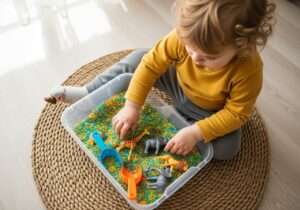
Sensory bins are an easy and powerful way to stimulate your one-year-old’s senses.
These small containers can be filled with everyday materials like rice, oats, dry pasta, pom-poms, or water beads (always under close supervision).
By scooping, grabbing, pouring, and feeling different textures, your toddler gets to explore through touch, which helps improve fine motor skills and sensory awareness.
You can theme your bins seasonally—add plastic leaves in the fall or mini eggs in spring—and watch your child discover new sensations while learning cause and effect.
2. Bubble Play

Bubbles bring pure joy and wonder to toddlers. Blowing bubbles helps children visually track movement, encourages crawling or walking as they chase them, and introduces them to the fun of popping something so light and magical.
This simple activity supports visual-motor coordination, spatial awareness, and even language as you use playful words like “pop,” “float,” and “catch.”
You can use a standard bubble wand or go for a no-hassle bubble machine that fills the air with dozens of bubbles for uninterrupted fun.
Read More: A little boo is due baby shower ideas
3. DIY Obstacle Course
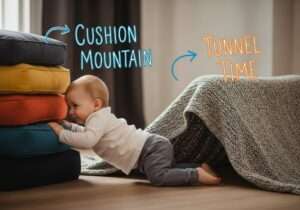
Turning your living room into an obstacle course is a creative way to promote gross motor development.
Use pillows, blankets, tunnels, and boxes to create a safe course that encourages crawling, climbing, and balancing.
For example, you can make a tunnel with two chairs and a blanket or a “mountain” using couch cushions.
As your one-year-old maneuvers through the course, they build strength, balance, and coordination.
It’s also a great way to burn off energy indoors on rainy days while keeping play engaging and interactive.
4. Water Play

Water is a fascinating material for toddlers. A shallow basin or baby pool filled with water and safe objects like plastic cups, spoons, or bath toys can keep your child entertained for quite some time.
Pouring, splashing, and scooping introduce basic concepts of volume, gravity, and temperature, all while enhancing hand-eye coordination.
You can also freeze small toys in ice cubes and let your toddler “rescue” them as a fun science twist.
Always supervise water play closely—even shallow water can pose risks for young children.
5. Push and Pull Toys
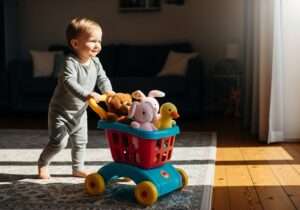
Once your child starts walking or cruising, push-and-pull toys become both entertaining and functional.
Items like toddler-sized shopping carts, wagons, or popper toys provide support while encouraging movement and muscle control.
These toys help build leg strength and stability while giving children a sense of accomplishment as they move independently.
Pull toys also promote coordination as toddlers learn to manage speed, direction, and balance at the same time.
Just be sure to choose toys that are sturdy and designed for your child’s weight and age.
Also Check: Fall baby announcement ideas
6. Read Together
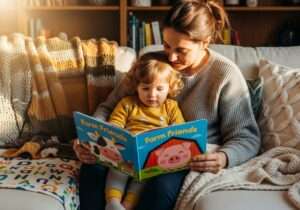
Reading is one of the most beneficial things you can do with your one-year-old.
Even if they don’t sit through an entire book, looking at pictures, listening to your voice, and pointing at objects supports language development, attention span, and emotional bonding.
Choose board books with textures, lift-the-flap elements, or rhymes to keep your child engaged.
Ask simple questions like “Where’s the dog?” or “Can you point to the ball?” to make reading more interactive and help your toddler learn object recognition.
7. Stacking and Nesting
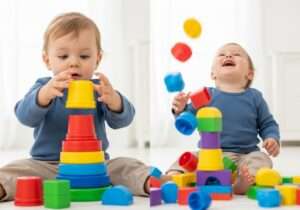
One-year-olds are just beginning to grasp spatial relationships, which makes stacking and nesting toys perfect for this stage.
Whether it’s stacking cups, blocks, or rings, your toddler is learning size comparison, balance, and cause-and-effect.
Knocking over towers may be even more exciting than building them! These simple actions strengthen hand-eye coordination and problem-solving skills.
You can also use everyday objects like plastic containers or lids if you don’t have specific toys—toddlers are resourceful.
8. Dance Party

Movement is not only fun—it’s also essential for development. A mini dance party is a joyful way to get your toddler moving and grooving.
Play cheerful music and dance together in the living room. Encourage clapping, stomping, spinning, or bouncing to the beat.
Dancing helps with rhythm, coordination, balance, and body awareness. It also supports emotional development as music can lift moods, reduce fussiness, and create happy bonding moments.
You don’t need fancy equipment—just a playlist and some space to move!
9. Nature Walks
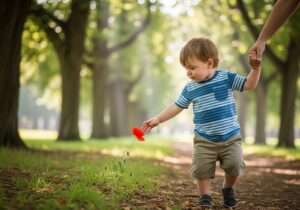
Outdoor walks are like mini adventures for one-year-olds. Instead of rushing, go at your toddler’s pace and let them explore grass, rocks, leaves, bugs, or puddles.
You can point out birds, cars, flowers, or animals along the way to build vocabulary and encourage observation.
These walks provide rich sensory input—sunlight, wind, textures—and offer early lessons in nature appreciation and curiosity.
Use a stroller for breaks, but let your toddler walk or toddle when it’s safe to do so. Fresh air and nature help with sleep and mood too.
Related Post: Stay at home mom outfits
10. Imaginative Play
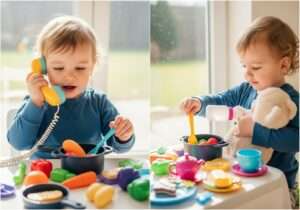
Even at one year old, toddlers start mimicking the world around them. Give them a toy phone, pretend food, a doll, or a mini broom, and they’ll begin copying your actions.
Imaginative play builds social-emotional skills, teaches problem-solving, and encourages creativity.
It also helps with language as they start labeling objects or talking to toys.
You might hear babble conversations or see them “feeding” their stuffed animal—and it’s all a sign that your child is learning by pretending.
Suggested Toys & Supplies (Affiliate Links)
Here are a few toddler favorites to pair with the activities:
-
🧺 Sensory Bin Starter Kit – Non-toxic, toddler-safe fillers
Why These Activities Matter
Each of these one year old activities helps nurture critical areas of development:
-
Fine motor skills (grasping, pouring, stacking)
-
Gross motor skills (walking, crawling, climbing)
-
Language and communication (reading, pretend play)
-
Sensory exploration (textures, sounds, movement)
Best of all, they allow you to bond with your little one while watching them grow more curious and confident every day.
Frequently Asked Questions
Q: How long should I do activities with my one-year-old?
A: Keep sessions short—5 to 15 minutes is usually enough. Follow your child’s lead and don’t stress if they lose interest quickly. At this age, variety and repetition are key!
Q: Are screen-based activities okay for one-year-olds?
A: Experts recommend minimal screen time under age two. Focus on hands-on and interactive play as much as possible.
Q: What if my toddler doesn’t like a certain activity?
A: That’s totally normal! Every child is different. Rotate through different types of play—movement, sensory, quiet time—and see what sparks their interest.
Final Thoughts
Watching your one-year-old grow and explore is one of the most magical parts of parenting. These one year old activities are not only fun but also help foster confidence, creativity, and important developmental milestones. Keep it simple, be present, and don’t forget to laugh along the way—because your toddler definitely will!
Affiliate Disclosure: As an Amazon Associate, I earn from qualifying purchases. This post may contain affiliate links. This means I may earn a small commission at no extra cost to you.


